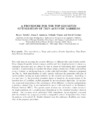Identificador persistente para citar o vincular este elemento:
https://accedacris.ulpgc.es/jspui/handle/10553/54746
| Título: | A procedure for the top geometry optimization of thin acoustic barriers | Autores/as: | Toledo Quintana, Rayco Aznárez González, Juan José Maeso Fortuny, Orlando Fco Greiner, David |
Clasificación UNESCO: | 3313 Tecnología e ingeniería mecánicas | Palabras clave: | Thin noise barriers Shape optimization Genetic Algorithms Dual Boundary Element Formulation |
Fecha de publicación: | 2014 | Conferencia: | 11th World Congress on Computational Mechanics (WCCM) / 5th European Conference on Computational Mechanics (ECCM) / 6th European Conference on Computational Fluid Dynamics (ECFD) | Resumen: | This work aims at assessing the acoustic efficiency of different thin noise barrier models. These designs frequently feature complex profiles and their implementation in shape optimization processes may not always be easy in terms of determining their topological feasibility. A methodology to conduct the shape design optimization of thin cross section acoustic barriers by idealizing them as profiles with null boundary thickness is proposed (see Fig. 1). Such simplification of reality greatly facilitates the geometric definition of barrier profiles, having no major influence on the acoustic performance. According to previous work [5], the procedure presented herein is based on the maximization of the insertion loss of candidate profiles proposed by an evolutionary algorithm. As application, numerical simulations of the performance of two different top barrier configurations of practical interest (Fig. 1) are conducted by use of a 2D code based on the Boundary Element Method (BEM). The special nature of these sort of barriers makes necessary the implementation of a complementary formulation to the classical boundary element method. The inclusion of an additional BEM formulation (hyper-singular) combined with the classical one (singular) provides a compatible system of equations that allows the problem to be solved [9]. Results obtained show the usefulness, flexibility and versatility of the proposed procedure. | URI: | https://accedacris.ulpgc.es/handle/10553/54746 | ISBN: | 9788494284472 | Fuente: | 11th World Congress on Computational Mechanics, (WCCM 2014), 5th European Conference on Computational Mechanics, (ECCM 2014) and 6th European Conference on Computational Fluid Dynamics, (ECFD 2014) / Eugenio Oñate, Xavier Oliver and Antonio Huerta (Eds), p. 3968-3978 |
| Colección: | Actas de congresos |
Citas SCOPUSTM
1
actualizado el 08-jun-2025
Visitas
95
actualizado el 01-nov-2024
Descargas
21
actualizado el 01-nov-2024
Google ScholarTM
Verifica
Altmetric
Comparte
Exporta metadatos
Los elementos en ULPGC accedaCRIS están protegidos por derechos de autor con todos los derechos reservados, a menos que se indique lo contrario.
